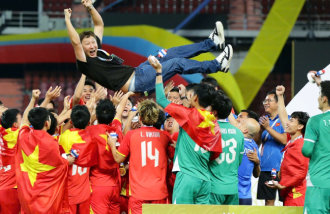How Great Success is Made

Author: Jeon Chang-hyeop and other co-authors
264 pages, 11,000 won, published by Wisdomhouse
It is not wise for you to sit helplessly, although business seems to have been stuck in dullness forever. There has always been a person who creates a success story under adverse conditions. Furthermore, some triumphs are only possible under unfavorable times of depression.
Rather than being focused on some trivial problems that prevent you from going further, what about learning a lesson from the experiences of the success makers who went ahead of you? They might help you come up with aspiring ideas. Five journalists, who are working at economic daily newspapers, wrote 10 success codes after having in-depth interviews with nine business people, who obtained mythological success.
Success Code No. 1. Can you wager all you have? Jo Woon-ho, CEO of Woongin Foods, took a risk with rice beverages when the company was undergoing deficit, not heeding the advice from the parent Woongjin Groups. The outcome was a new record, selling 100,000,000 bottles within the shortest amount of time in the history of the beverage market. The producer of Nanta (a homegrown, non-verbal percussion performance), Song Seung-whan, loaned from the bank, took his friends house as security, and invested all to the show. These two people first placed their situations seemingly recklessly as if standing on the edge of a cliff, and then endeavored to the fullest to achieve success.
Success Code No. 2. Are you a sharp analyzer looking into the niche market? CEO Seo Yeong-pil at Able C&C, who achieved unbelievable success with the cosmetics brand Missha, lowered the price line of expensive cosmetics to the reasonable but not cheap level in the flooding cosmetics market. It was the outcome of appealing to the emotions of the average netizen, following the trend of utilizing the Internet for marketing. Jeong Hae-jin, the CEO of Recominternational, accurately read the potential market for mens salons and created the myth of building up 100 billion won out of 700,000,000 won.
Success Codes No. 3 and 4. Do you have either of the two: a special intuition or prudence? CEO of Mboat Entertainment Park Gyeong-jin, who recruited and developed singer Wheesung and Big Mama into big stars, says, If I have a positive hunch, success is guaranteed. In terms of intuition and prudence, two movie directors, Kang Woo-suk of Silmido and Kang Jae-gyu of Waving the Tae Geuk Flag, are good models for comparison. Director Kang Woo-suk has enough sharp intuition to say, If I see a prospect, it definitely brings audiences and turns out to be a blockbuster. Meanwhile, Director Kang Je-gyu is a very cautious type, and he spent three months making a hypothetical screen of Waving the Tae Geuk Flag. These two directors have reached the top of the best Korean movie directors, benefiting from their strong points.
Success Code No. 5. Are you oriented to the world market? CEO of the toy company Sonogong, Choi Shin-gyu, who created a myth of a top with top blade, invested two billion won in making the cartoon Top Blade that cost a total of six billion won. He had a hunch for success after witnessing the successful phenomenon of Top Blade in the Japanese market. Yang Deok-joon, CEO of the manufacturer of the MP3, RainCom, succeeded at advertising its brand eyeRiver as the best MP3, and received orders from the biggest U.S. electronics store, Best Buy: Stock eyeRiver at our 500 stores within three months. And, it successfully answered the order and has been preparing to cover the whole U.S. MP3 market after a good start.
Although the interviewees were all from various fields, four to five general success codes have been found: 1) It is the struggle that makes us strong 2) We dont pursue stability and are always ready to willingly quit the present stable job 3) Working is crazy fun 4) Embrace people with warm hearts. 5) We know what is considered desirous by the masses. These five codes are the rest of the success codes in the book. How many of the success codes do you, your company, or your department, have among the 10?
Yoon-Jong Yoo gustav@donga.com







